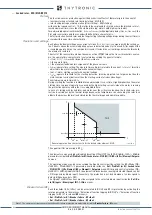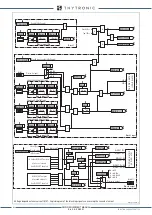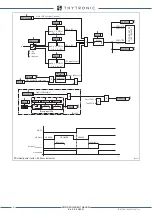
210
FUNCTION CHARACTERISTICS
Similarly the trip of the IE(H)>> element may be inhibited by start of the third element (IE(H)>>>) by
setting
ON
the Disable IE(H)>> by start IE(H)>>> (
IE
(H)
>>disbyIE
(H)
>>>
) parameter available
inside the
Set \ Profile A (or B) \ Calculated residual overcurrent-50N(Comp)/51N(Comp) side H \
IE(H)>>> Element
\ Setpoints
menus for side H element, the
IE
(L)
>>disbyIE
(L)
>>>
parameter
available inside the
Set \ Profile A (or B) \ Calculated residual overcurrent-50N(Comp)/51N(Comp)
side L \
IE(L)>>> Element
\ Setpoints
menus for side L element and the
IE
(T)>
>disbyIE
(T)
>>>
parameter available inside the
Set \ Profile A (or B) \ Calculated residual overcurrent-50N(Com-
p)/51N(Comp) side T \
IE(T)>>> Element
\ Setpoints
menus for side T element.
All the parameters can be set separately for
Profile A
and
Profile B
E’ regolabile un tempo di ripristino costante per ciascuna delle soglie (
t
E(H)
>
RES
,
t
E(H)
>>
RES
,
t
E(H)
>>>
RES
per il lato H e
t
E(L)
>
RES
,
t
E(L)
>>
RES
,
t
E(L)
>>>
RES
per il lato L).
Breaker failure (BF)
Each thresholds (IEC>, IEC>>, IEC>>>) can be associated to BF (H) and BF (L) protection by activating
the relative parameter in the matrices “Selection of function tripping for BF (H)” or “Selection of
function tripping for BF (L)” in relevant
BF
menus
[1]
:
• Set \ Profile A (or B) \ Breaker failure - BF side H
• Set \ Profile A (or B) \ Breaker failure - BF side L
Second harmonic restraint
For all elements, a block from the second harmonic restraint may be set by setting
ON
the
IEC>2n-
dh-REST, IEC>>2ndh-REST, IEC>>>2ndh-REST
.
The parameters are available inside the
Set \ Profile A (or B) \ Residual overcurrent-50N(Com-
p)/51N(Comp) \
IEC> Element
(
IEC>> Element
,
IEC>>> Element) \ Setpoints
menus.
Cold load pickup (CLP)
If the CLP function (Cold Load Pick-up) is enabled for
element blocking
, the element may be blocked
for an adjustable time interval, starting from circuit breaker closure.
If the CLP function (Cold Load Pick-up) is enabled for
setting change
, the selected threshold may be
changed for an adjustable time interval, starting from the circuit breaker closure.
The operating mode may be select by setting
ON-Element blocking
or
ON-Change setting
the
IECCLP> Mode, IECCLP>> Mode, IECCLP>>> Mode
parameter.
The operating modes and the CLP Activation time parameters
(
tECCLP>, tECCLP>>
e
tEC-
CLP>>>
) may be adjusted inside the
Set \ Profile A (or B) \ Residual overcurrent-50N(Com-
p)/51N(Comp) \
IEC> Element
(
IEC>> Element
,
IEC>>> Element) \ Setpoints
menus.
The threshold inside CLP (
IECCLP>def, IECCLP>inv,....
) can be set inside the
Set \ Profile A (or B)
\ Residual overcurrent-50N(Comp)/51N(Comp) \
IEC> Element
(
IEC>> Element
,
IEC>>> Element) \ De-
finite time (Inverse time)
menus.
For every of the four thresholds the following block criteria are available:
Logical block (Block1)
If the
IEC>BLK1, IEC>>BLK1
and/or
IEC>>>BLK1
enabling parameters are set to
ON
and a bi-
nary input is designed for logical block (Block1), the concerning element is blocked off whenever the
given input is active.
[2]
The enabling parameters are available inside the
Set \ Profile A (or B) \ Resi-
dual overcurrent-50N(Comp)/51N(Comp) \
IEC> Element
(
IEC>> Element
,
IEC>>> Element) \ Setpoints
menus, while the
Block1
function must be assigned to the selected binary input inside the
Set \
Board1(2) inputs \ Binary input IN1-1...INx-x)
menus .
Selective block (Block2)
All along the protective elements the selective block may be set.
The logic selectivity function may be performed by means any combination of the following I/O:
• One committed pilot wire input (BLIN1).
Note 1 The common settings concerning the Breaker failure protection are adjustable inside the
Breaker Failure - BF
menu.
Note 2 The description of the logical block (Block 1) function may be found in the “Logic Block” paragraph inside
CONTROL AND MONITORING
section
IEC> element residual overcurrent 50N(Calc)/51N(Calc) - Timers
IE
C
> Start
IE
C
> Trip
RESET
INPUT
t
EC
t
EC
t
EC>RES
t
EC>RES
t
EC>RES
t
XMR-D EQUIPMENT MANUAL
Ed. 2.9 - 02/2021






























